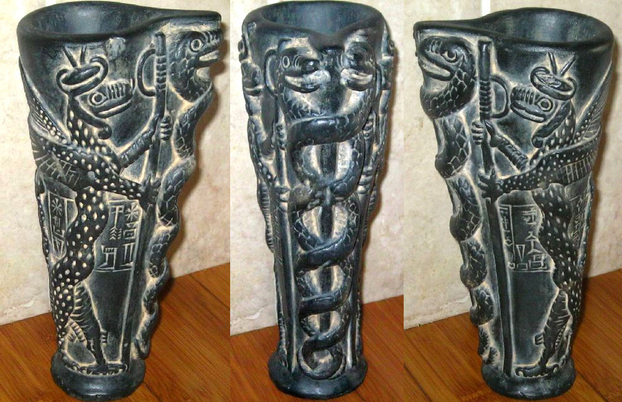
The conflict between Yahweh and the snake in the Book of Genesis is a kind of historicization of the ancient trope of the storm god who fights the multi-headed dragon of the primeval ocean such as Leviathan. To the Babylonians, it was Tiamat, who was originally the primal mother of all the gods in Sumerian mythology, and the storm god Marduk slaying her represented him bringing form (empire) to chaos (local authoirity). The association of the snake with Eve is not just Biblical. You see it with Medusa and the Gorgons, Alexander’s mother Olympias’ orgiastic snake-worshiping cult of the dying-and-rising god Dionysus, Lilith, Lamia, etc. The long ending of Mark epitomizes his (Montanist?) sect as a snake-handling cult focused on healing and drinkable poisons, and in fact the Old Testament defined a “witch” as a posioner, which in Greek is pharmekus (pharmacy).
The “snake-pole” that Moses uses sounds like a caduceus (or Asclepius rod, whatever), a symbol of healing. The caduceus is also found on a Sumerian vase dedicated to Ningishzida, who like dying-and-rising god Dumuzi, was said to have guarded the gates of heaven from the Sumerian priest Adapa (Adam) until he sympathized with Dumuzi’s and Ningishzida’s deaths. Dumuzi bore the title “Mother-Dragon-of-Heaven”, which he apparently inherited from Nammu, and his wife Inanna, or Asherah, was the Queen of Heaven who worship Jeremiah scolded. The Book of Ezekiel complained bitterly that the women of Jeruslaem would worship Tammuz, or Dumuzi, right outside the Temple, and strangely instituted an Ash Wednesday-like ritual of wiping a Tau mark on the foreheads of those who wanted to *kill* Dumuzi worshipers, which seems to indicate there’s been some “cultural appropriation” in this book. Plutarch argues that the thyrsus and trimbles used in the Temple confirm that Yahweh was originally Bacchus (Dionysus).
Moses’ caduceus pole was probably identical to the “Asherah trees” that were Hezekiah and Josiah are celebrated for tearing down in localized “high places”, which would explain why Hezekiah is also the king who destroyed it. Jesus’ crucifixion is specifically associated with Moses’ pole in the Gospel of John. Vases of Dionsysus show participants eating a bread and wine Eucharist in front of a pole bearing the likeness of a dead Dionysus.
These snaky-feminine local cults were always in conflict with the nationalistic storm god temple priesthoods. If you were a rebel, you tended to choose the dying-and-rising shepherd god as the symbol of the underdog. Spartakus chose Dionysus. Augustus’ daughter Julia chose Marsyas. If Moses was leading Semetic rebels, this “rebel underdog” iconography makes sense, just as it makes equal sense that once they became a kingdom and wanted to stifle rebellion, the state would turn against such iconography.
This is why Babylon’s creation story is about the murdering the mother of the gods and why the cult of Dionysus was long suppressed from Homeric era of mythology, such that historians long thought him a new god until they discovered his name in the Mycenaean era. Dionysus was finally revised and reformed into something the state could accept. As Cicero, one of those reformers of Dionysus, pointed out, they definitely liked the part of the mystery religions about going to heaven after you die instead of the underworld, as the state religion typically said. An ancient Sumerian story about Gilgamesh finding the tree of Inanna infested with a snake, a Lilith and a owl. He kills the snake, scares off the Lilith and the owl, and then chops down Inanna’s tree and builds a couch for her out of it. The story seems to indicate that these kinds of “reforms” were common, where, just like Hezekiah and Josiah, Gilgamesh tore down the Asherah/Inanna trees in the sacred groves of the local high places and then established official worship in the city temple (Inanna’s new couch).